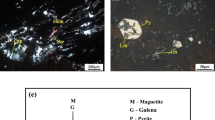Abstract
The chemical compositions, mineralogical characteristics, as well as dissemination of iron- and phosphorus-based minerals were studied for the E’xi oolitic hematite from western Hubei Province in China by using chemical analysis, optical microscope, electron probe micro-analyzer (EPMA) and energy dispersive spectroscopy (EDS). It is found that this kind of oolitic hematite ore contains 47.71% TFe, 10.96% SiO2, as well as 0.874% P, with hematite as the dominant Fe-bearing minerals, and quartz, chamosite, illite and cellophane as main gangue minerals. The microscope examination showed that the ore has an oolitic structure, with some ooids principally formed by a series of concentric layers of hematite collophanite around nucleus that is hematite in the association with collophanite. Based on the EPMA and EDS analysis, it can be known that some ooids are primarily composed of hematite and collophanite. The separation can be achieved through fine grinding for those collophanite laminae with a higher P content. However, the dissemination of two minerals at the interface will result in the difficulty in effective separation. Besides, some ooids are made of chamosite with some nucleus formed of quartz, which is principally finely disseminated with hematite. In view of the close association and dissemination of iron- and phosphorus-based minerals in the ooids, it is found that the process of stage-grindings and stage-separations can be adopted to effectively increase the iron recovery and decrease the P content in the concentrate to some extent.
Similar content being viewed by others
References
ZHANG Han-quan. Mineralogical properties and tendency on utilizatiing methods of oolitic hematite [J]. China Metallurgy, 2013, 23(11): 6–10. (in Chinese)
LUO Li-qun, CHEN Min, YAN Hao-tian, CUI Shuang-shuang, ZHANG Yan-juan. Magnetic reduction roasting and magnetic separation of oolitic iron ore [J]. The Chinese Journal of Process Engineering, 2014, 14(4): 593–598. (in Chinese)
SUN Yong-sheng, HAN Yue-xin, GAO Peng, ZHOU Man-geng. Study on process mineralogy of a high phosphorus oolitic hematite ore [J]. Journal of Northeastern University: Natural Science, 2013, 34(12): 1773–1777. (in Chinese)
SONG Shao-xian, EMESTO F C, ZHANG Yi-min, ALEJANDRO L V. Morphological and mineralogical characterizations of oolitic iron ore in the exi region, China [J]. International Journal of Minerals Metallurgy and Materials, 2013(2): 113–118.
BAIOUMY H M. Iron–phosphorus relationship in the iron and phosphorite ores of egypt [J]. Chemie der Erde - Geochemistry, 2007, 67(3): 229–239.
YU Wen, SUN Ti-chang, CUI Qiang. Can sodium sulfate be used as an additive for the reduction roasting of high-phosphorus oolitic hematite ore? [J]. International Journal of Mineral Processing, 2014, 133: 119–122.
XU Cheng-yan, SUN Ti-chang, KOU Jue, LI Yong-li, MO Xiao-lan, TANG Li-gang. Mechanism of phosphorus removal in beneficiation of high phosphorous oolitic hematite by direct reduction roasting with dephosphorization agent [J]. Transactions of Nonferrous Metals Society of China, 2012, 22(11): 2806–2812.
LIN Qing, ZHONG Le-le, GONG Wen-qi, WANG En-wen, LU Yu, XIA Dao-hong. Experimental study on magnetic separation of oolitic hematite ore [J]. Advanced Materials Research, 2014, 834: 374–377.
GUO Chao, WAN Gui, FU Jian-gang, CHEN Kai-da. Recovery a refractory oolitic hematite by magnetization roasting and magnetic separation [J]. Advanced Materials Research, 2012, 361: 305–310.
TANG Hui-qing, GUO Zhan-cheng, ZHAO Zhi-long. Phosphorus removal of high phosphorus iron ore by gas-based reduction and melt separation [J]. Journal of Iron and Steel Research (International), 2010, 9: 1–6.
HAN H, DUAN D, WANG X, CHEN S. Innovative method for separating phosphorus and iron from high-phosphorus oolitic hematite by iron nugget process [J]. Metallurgical and Materials Transactions B, 2014, 45(5): 1634–1643.
OLUBAMBI P A, NDLOVU S, POTGIETER J H, BORODE J O. Mineralogical characterization of ishiagu (nigeria) complex sulphide ore [J]. International Journal of Mineral Processing, 2008, 87(3, 4): 83–89.
SANTOS L D, BRANDAO P R G. Morphological varieties of goethite in iron ores from minas gerais, brazil [J]. Minerals Engineering, 2003, 16(11, Supplement 1): 1285–1289.
PETIT-DOMINGUEZ M D, RUNDIO M I, GALAN-SAULNIER A, GARCIA-GIMENEZ R. Usefulness of geological, mineralogical, chemical and chemometric analytical techniques in exploitation and profitability studies of iron mines and their associated elements [J]. Journal of Geochemical Exploration, 2008, 98(3): 116–128.
LUO Li-qun, LI Jin-liang, CAO Jia-hong. Process mineralogy and factors affecting mineral processing for copper-nickel ore in Hami [J]. The Chinese Journal of Nonferrous Metals, 2014, 24(7): 1846–1855. (in Chinese)
OMRAN M, FABRITIUS T, ELMAHBY M A, ABDEL-KHALEK A N, EL-AREF M, ELMANAWI E A. XPS and FTIR spectroscopic study on microwave treated high phosphorus iron ore [J]. Applied Surface Science, 2015, 345: 127–140.
GRGIC D, GIRAUD A, AUVRAY C. Impact of chemical weathering on micro/macro-mechanical properties of oolithic iron ore [J]. International Journal of Rock Mechanics and Mining Sciences, 2013, 64: 236–245.
HOPE G A, WOODS R, MUNCE C G. Raman microprobe mineral identification [J]. Minerals Engineering, 2001, 14(12): 1565–1577.
DONSKOI E, SUTHERS S P, FRADD S B, YOUNG J M, CAMPBELL J J, RAYNLYN T D, CLOUT J M F. Utilization of optical image analysis and automatic texture classification for iron ore particle characterisation [J]. Minerals Engineering, 2007, 20(5): 461–471.
LI Guang-hui, ZHANG Shu-hui, RAO Ming-jun, ZHANG Yuan-bo, JIANG Tao. Effects of sodium salts on reduction roasting and Fe–P separation of high-phosphorus oolitic hematite ore [J]. International Journal of Mineral Processing, 2013, 124: 26–34.
Author information
Authors and Affiliations
Corresponding author
Additional information
Foundation item: Project(51474161) supported by the National Natural Science Foundation of China
Rights and permissions
About this article
Cite this article
Luo, Lq., Zhang, Hq. Process mineralogy and characteristic associations of iron and phosphorus-based minerals on oolitic hematite. J. Cent. South Univ. 24, 1959–1967 (2017). https://doi.org/10.1007/s11771-017-3604-8
Received:
Accepted:
Published:
Issue Date:
DOI: https://doi.org/10.1007/s11771-017-3604-8




